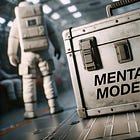Friction - Mental Model
Every day, you fight against an invisible force — it’s everywhere, uses up your willpower, and slows you down. That’s friction.
I’m not a morning person (yet). Before 8 a.m., my brain feels foggy, like it’s still asleep.
So when I had to wake up at 3 a.m. recently to catch a morning plane, I knew I would forget something if I didn’t plan. I prepared my clothes, made a checklist, and even put a note in my shoe so I wouldn’t forget to go through it — a small system I call “removing friction for my future self”.
Friction
In physics, friction is the resistance between surfaces that are moving.
In life, it’s anything that makes a task harder than it should be — anything that adds effort or resistance to our routines, work, or systems.
As a mental model, it helps us notice two sides of friction:
More friction makes things harder.
Less friction makes things easier.
This idea is simple, but it’s often ignored. When used well, it can improve both daily habits and company operations.
Life & Habits
Our brains try to save energy, which can sometimes look like laziness. But the easier something is, the more likely we are to do it.
This is why reducing friction is a key part of building good habits.
Example: Put a book on your pillow. You will pick it up before sleeping, even if you don’t read it. There’s no friction.
We can also add friction to stop bad habits.
Example: Making sure that you have no chocolate or any kind of sweets at home adds friction, because you would need to go out and buy them if you have a sweet tooth.
These ideas work at a personal level, but also in the way teams and companies operate.
Friction in Factory
Toyota is famous for its Production System (TPS), one of the best examples of reducing friction in practice:
Standards: Every task is done the same way, so workers don’t have to guess.
Time: Just-in-time production brings parts exactly when needed. No delays.
Continuous improvement (Kaizen): Small changes are made all the time to reduce friction.
Communication: Workers can pull a cord to stop the line and signal a problem immediately.
My favourite is the “pull-the-cord” system that stops the whole process. In other companies, workers only marked mistakes for others to fix later. At Toyota, pulling the cord stopped the line so the problem could be fixed straight away. This made workers feel more responsible and improved the process.
More examples of playing with friction:
Good apps reduce friction to make things fast and easy.
A “Buy Now” button works better than long forms with five steps.
Two-factor authentication adds friction, on purpose. It makes hacking harder and keeps our accounts safe.
Summary
Friction is everywhere, and it affects everything we do.
Ask yourself:
What do I want to do more, and how can I make it easier?
What do I want to do less, and how can I make it harder?
Thanks for reading!
— Michał
Post Notes
References
In the book “Atomic Habits”, James Clear explained that a big part of habit-forming strategies was about removing friction and shaping our environment.
Bloomberg video: “How Toyota Changed The Way We Make Things”
Discover Weekly — Shoutouts
Articles that might help you explore new perspectives, which I’ve read recently:




Short but to the point. !!!!